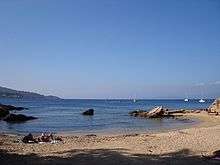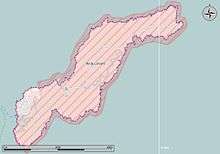Île du Levant

Île du Levant (pronounced [il dy ləvɑ̃]), sometimes referred to as Le Levant, is a French island in the Mediterranean off the coast of the Riviera, near Toulon. It is one of the four that constitute the Îles d'Hyères.
Geography
The island is 8 by 2 kilometres (5.0 by 1.2 mi), and located in the Gulf of Lion. About 90% of the island is reserved for a military missile test center (the Centre d'Essais de Lancement de Missiles) which has launched numerous research and testing rockets since its establishment in 1948. The remaining 10% is open to civilians.


History
Monks lived on the island beginning in the 15th century; the ruins of their monastery still exist on the island. From 1861 until 1878, the island was a penitentiary for young offenders and orphans, of whom 89 died here. A plaque (located on the military part of the island) commemorates them.
In 1931, Gaston and André Durville, both doctors, established Héliopolis, Europe's first village dedicated to naturism, on the island. As the doctors Durville said in 1931
Heliopolis should not be a city or village, not an agglomeration of houses or luxury villas with garages, casinos, theaters, factories, business houses, but a simple rustic city where air and sunlight lovers come in the quiet of a beautiful nature, rest from the fatigue of artificial civilisation of cities, and enjoy simple and healthy holiday, with the only luxury of high ideals and the only concern for a more robust health.[1]
The village was built on hillsides and is dominated by Fort Napoleon. The village has a post office, a city hall, a chapel and a police station as well as a grocery, a bakery, and two galleries. In 2017 a pizzeria will be opening. The port area houses the office of the Capitaine du Port, a clothing store and small general store. In between there is a bazaar (Le Bazar d'Héliopolis) offering food, hardware, a tabac and cafe bar. There are a number of hotels and bed-and-breakfasts, and eight restaurants (Le Gecko, La Fourmi, La Palmeraie, La Gambaro, Héliotel, Le Minimum, La Pomme d'Adam, La Bohème), all catering for naturists.
Climate
| Climate data for Île du Levant (1981–2010 averages, extremes 1968–present) | |||||||||||||
|---|---|---|---|---|---|---|---|---|---|---|---|---|---|
| Month | Jan | Feb | Mar | Apr | May | Jun | Jul | Aug | Sep | Oct | Nov | Dec | Year |
| Record high °C (°F) | 20.7 (69.3) |
22.3 (72.1) |
23.3 (73.9) |
25.1 (77.2) |
29.1 (84.4) |
34.2 (93.6) |
34.9 (94.8) |
38.3 (100.9) |
31.2 (88.2) |
27.0 (80.6) |
23.1 (73.6) |
20.0 (68) |
38.3 (100.9) |
| Average high °C (°F) | 12.1 (53.8) |
12.6 (54.7) |
14.7 (58.5) |
16.7 (62.1) |
20.5 (68.9) |
24.4 (75.9) |
27.7 (81.9) |
28.0 (82.4) |
24.3 (75.7) |
20.1 (68.2) |
15.7 (60.3) |
12.8 (55) |
19.2 (66.6) |
| Daily mean °C (°F) | 9.8 (49.6) |
9.9 (49.8) |
11.7 (53.1) |
13.5 (56.3) |
17.1 (62.8) |
20.7 (69.3) |
23.8 (74.8) |
24.1 (75.4) |
21.0 (69.8) |
17.5 (63.5) |
13.4 (56.1) |
10.7 (51.3) |
16.1 (61) |
| Average low °C (°F) | 7.5 (45.5) |
7.2 (45) |
8.7 (47.7) |
10.3 (50.5) |
13.8 (56.8) |
17.0 (62.6) |
19.9 (67.8) |
20.2 (68.4) |
17.6 (63.7) |
14.9 (58.8) |
11.0 (51.8) |
8.6 (47.5) |
13.1 (55.6) |
| Record low °C (°F) | −6.2 (20.8) |
−8.2 (17.2) |
0.8 (33.4) |
2.9 (37.2) |
7.0 (44.6) |
10.0 (50) |
13.3 (55.9) |
12.7 (54.9) |
10.6 (51.1) |
4.6 (40.3) |
1.1 (34) |
−1.0 (30.2) |
−8.2 (17.2) |
| Average precipitation mm (inches) | 66.0 (2.598) |
47.6 (1.874) |
38.8 (1.528) |
57.5 (2.264) |
37.1 (1.461) |
23.2 (0.913) |
7.8 (0.307) |
19.2 (0.756) |
53.7 (2.114) |
84.0 (3.307) |
75.8 (2.984) |
71.3 (2.807) |
582.0 (22.913) |
| Average precipitation days (≥ 1.0 mm) | 6.1 | 5.1 | 4.4 | 6.4 | 4.6 | 2.8 | 0.9 | 1.9 | 4.2 | 6.9 | 7.6 | 7.0 | 58.0 |
| Source: Meteo France[2] | |||||||||||||
Culture
The Bain de Diane and the Plage des Grottes (a nude beach) are reserved for naturists; nudity is formally obligatory there. Being nude is allowed (and expected) everywhere on the public area of the island, except in the immediate vicinity of the harbour and on the village square.[3] On these locations, it is formally necessary to wear what the French jokingly call French: le minimum,[lower-alpha 1][4] often a pareo or a string. In conformance with the relaxed atmosphere of the island, this rule is not really enforced, but generally well observed. Inside restaurants outside the village centre, some clothing, although often flimsy, is usually worn but toplessness (for women and men) is quite accepted there and le minimum considered sufficient attire; on the outside terraces, nudity is common, especially at lunch time. At least two restaurants, La Fourmi and Heliotel, actively encourage nude use, even at dinner. In August 2015 it became permitted to walk naked through the village square but le minimum is required if stopping.

The island sees a number of scuba divers; these generally do not partake in the nudist lifestyle.
The non-military part of the island is private property. The owners form the Association Syndicale Libre des Propriétaires à l'Île du Levant.
Outside Héliopolis naturist village, the other main tourist attraction is the Domaine des Arbousiers, a voluntary natural reserve of 19 hectares (47 acres), established on 3 December 1993.[5]
The island can be reached by boat from Hyères and from Le Lavandou. As no cars are allowed on the island (except for some four utility cars), these ferries do not take cars.
In popular culture
A 1956 film by Werner Kunz was called Isle of Levant and featured so-called "nudist camp" footage.
The island is used as a setting in the Robert A. Heinlein novel Glory Road and in the Mario Reading novel The Music Makers.
The island was mentioned in Are You Being Served? episode "Hoorah for the Holidays" as a presumed destination for Captain Peacock's annual vacation. Miss Brahms calls it "a nudist colony" but Captain Peacock insists it's a "nature camp".
The island, and a nod to its nudist history, was also featured in the French film Nos Futurs (Our Futures).
See also
Notes
- ↑ Le minimum is the term jokingly used by naturists on the island, for the tiny coverage required by regulations on a few locations. On the village square, near the harbour and inside shops and restaurants, the genitals have to be covered. As a good-humoured protest against this regulation, some naturists wear in these locations a tiny string, a transparant pareo or a loincloth that fulfils the legal requirement but does little to preserve modesty.
- ↑ "Heliopolis Naturist Resort History - Ile du Levant". iledulevant.com.fr. Retrieved 2016-06-18.
- ↑ "Ile du Levant (83)" (PDF). Fiche Climatologique: Statistiques 1981–2010 et records (in French). Meteo France. Archived from the original (PDF) on 5 April 2018. Retrieved 5 April 2018.
- ↑ Arrêté Municipal Hyères N° 25, 14 March 1978 (http://www.aln.fr/html/documents/Arr%EAt%E9_1978_03_14_Mairie_Hy%E8res_Naturisme_au_Levant.pdf); modified 20 April 2005 (http://www.aln.fr/html/documents/Arr%EAt%E9_2005_04_28_modif-arr%EAt%E9-1978-naturisme-Levant.pdf). In August 2015, the Mayor of Hyeres has informed the French Naturist Association that simply traversing the Village Square and its surroundings nude will henceforth be tolerated. ("Archived copy". Archived from the original on 2016-03-27. Retrieved 2016-03-24. ).
- ↑ Bisserbe, Noemie (10 March 2016). "On French Island, Nudists Rebuff Clothing Rules". Wall Street Journal. Retrieved 2016-06-18.
- ↑ Décision du Préfecture du Var, 3 December 1993.
Further reading
- Bauberot, Arnaud (2008). "De la nudité thérapeutique au nudisme, les naturistes français". Rives méditerranéennes (30): 101–116. doi:10.4000/rives.2403. ISSN 2103-4001.
- Villaret, Sylvain (2014). "Du projet utopique à la réalité: La création d'Héliopolis Première commune naturiste de France (1930-1939)". Histoire urbaine (in French) (41): 121–136. ISSN 1628-0482. Retrieved 2016-06-18.
External links
| Wikivoyage has a travel guide for Île du Levant. |
- Ile du Levant official tourist informations
- http://www.iledulevant.com.fr/en/
- Ile du Levant
- Ile du Levant Chronology and Launch Log
- Ile du Levant Naturist Web Site
- Ile du Levant Photo Gallery
- Map of the island in JPEG format, from the Hyères Office of Tourism